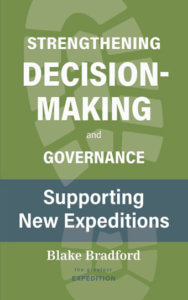Blake Bradford outlines strategies to make sure your meetings stay focused and productive. They include practicing mutual accountability, managing time carefully, and having a clear decision-making process for each agenda item.
I am emphatic in my belief that “meetings are not ministry.” But this does not mean that meetings don’t matter. Gathering in person or online for meetings is crucial. Fruitful meetings are our vehicle for decision-making and solid Christ-centered governance.
Group conversation, discernment, and decision-making are like tending a garden. While a solid agenda may plant the right seeds, a group is always in danger of heading off into the weeds, either by going off topic or wasting valuable time. Gardening is a constant battle with weeds that threaten to pull resources from the plants or even overwhelm them by crowding out and smothering what we are trying to grow. As we apply the gardening metaphor to meetings, I think of the weeding task as leading meetings in a way that creates optimal focus on the actual decision-making work.
Here are some recommendations as you do the weeding for your meetings:
1. Practice mutual accountability from the beginning.
We are accountable first to Jesus Christ and God’s mission for us as a church. If your leaders aren’t accountable, then no one will be.
2. Encourage leaders to come with a sense of curiosity and grace.
Members shouldn’t be afraid to ask questions. Outside agendas need to be left at the door. These meetings are God’s time.
3. Configure your space to have meaningful conversation.
Gather in a circle so you can see each other. Have team members sit at the table and observers sit in chairs along the wall to define those with voting rights clearly. Perhaps light a candle in the center representing Jesus at the table. I once attended an administrative council meeting at a church I was coaching where all the board members were seated up front in a row, and the “audience” were in rows in front of them. It reminded me of a City Council or School Board meeting where constituents could go up to the microphone to argue their point to the board. Meanwhile, the board members couldn’t even see each other. The space and configuration dictated an “us/them” approach to everything the board did.
4. Create a time docket for your meetings.
One recommendation is to post a time window for every agenda item. This practice of allocating time to each item requires the chair to be realistic with the time available and to calculate how much time can be given to each item. I have used a time docket for years, and it helps the chair create expectations for the team. Of course, the group can always adjust as needed, but without any printed time allocation team members can quickly get frustrated or feel like the chair is railroading the meeting. Notice that in both the matter of the time docket and the use of printed agenda questions with action designations, I am attempting to harness the entire team in being gardening partners in the weeding. By setting up clear expectations, the chair can rely on the group to self-regulate.
5. Create clear processes for addressing agenda items.
There are times when you will need to take votes. Consensus is a fine enough goal and it is lovely when the board is all in agreement, but consensus cannot be a requirement for your church to move forward. After a few decades, I still vividly remember a classroom exercise during a seminary leadership course. We were all given a role to play and told our hypothetical church would be given a large financial gift. Then, we were set free to figure out what to do with the large bequest. It was a mess. Some wanted to vote. The assigned chairperson wanted a unanimous consensus to move forward (a process she declared without input). Even with a bunch of seminarians playing with monopoly money, we spent over an hour with nothing to show of it but bruised feelings.
Since then, I have seen churches who utilize a unanimous consent requirement become immobilized by a minority of members who held the church’s future hostage. In an article in the Harvard Business Review, “How to Design an Agenda for an Effective Meeting” (March 19, 2005), Roger Schwarz recommends:
- Propose a process for addressing each agenda item. Agreeing on a process significantly increases meeting effectiveness, yet leaders rarely do it. Unless the team has agreed on a process, members will in good faith participate based on their own process. You’ve probably seen this in action: some team members are trying to define the problem, other team members are wondering why the topic is on the agenda, and still other members are already identifying and evaluating solutions.
- When you reach that item during the meeting, explain the process and seek agreement: “I suggest we use the following process. First, let’s take about 10 minutes to get all the relevant information on the table. Second, let’s take another 10 minutes to identify and agree on any assumptions we need to make. Third, we’ll take another 10 minutes to identify and agree on the interests that should be met for any solution. Finally, we’ll use about 15 minutes to craft a solution that ideally takes all the interests into account and is consistent with our relevant information and assumptions. Any suggestions for improving this process?”
Notice in Schwarz’s recommendation that the chair isn’t expected to have a single decision-making process and stick to it rigidly for every item and topic. Instead, the process can be customized as needed depending on the matter at hand.
All these recommendations are about tending to the garden, that is, the team members’ relationships and emotions during the meeting so that the decision-making work can be appropriately addressed without getting “stuck in the weeds.”
 This article is adapted from Strengthening Decision-Making and Governance Supporting New Expeditions (Market Square Books, 2022). Used by permission. The book is also available at Cokesbury and Amazon.
This article is adapted from Strengthening Decision-Making and Governance Supporting New Expeditions (Market Square Books, 2022). Used by permission. The book is also available at Cokesbury and Amazon.
Related Resources
- 7 Strategies to Master Meetings by Ann A. Michel
- The Art of Forging a Meaningful Consensus by Ann A. Michel
- Working with Committees and Boards by Alan Rudnick







